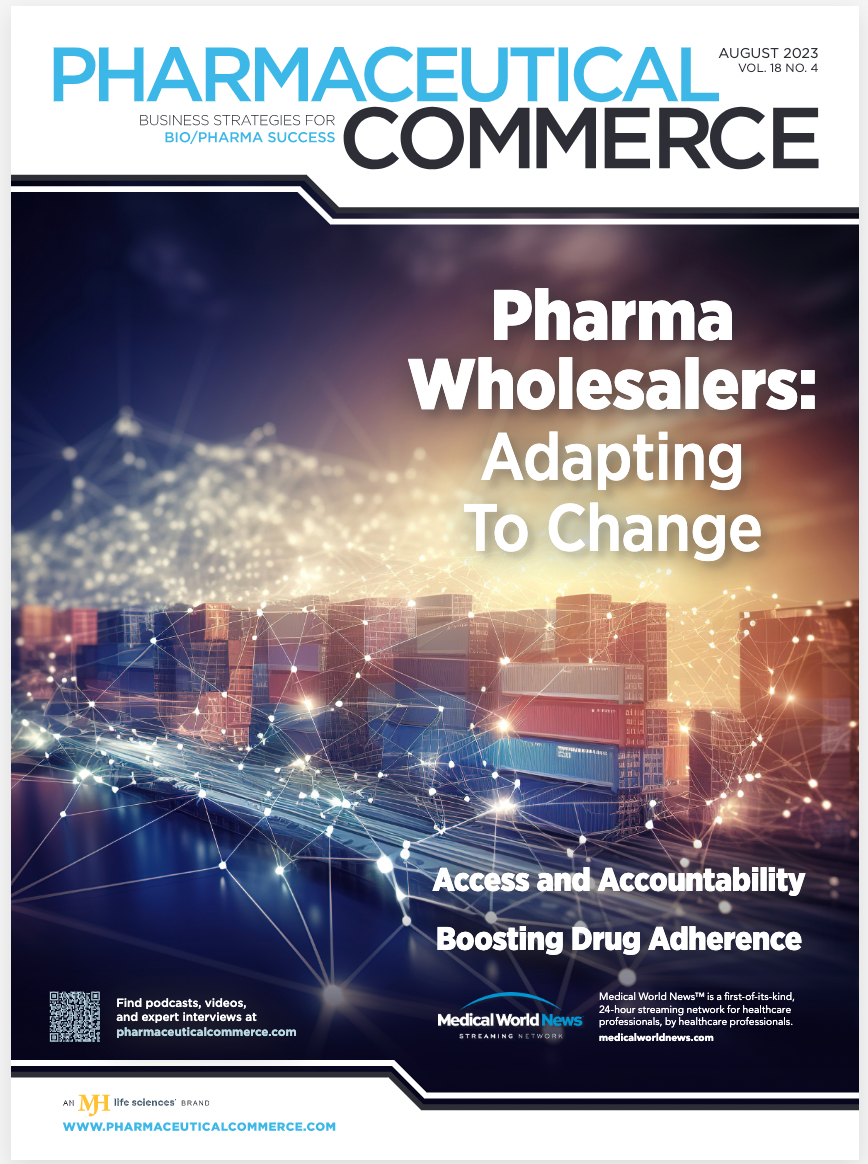Are ADMs a Viable Option for Pharma?
The key questions and considerations for drug manufacturers pursuing an effective alternative distribution model.

Three wholesalers — AmerisourceBergen (soon to be known as Cencora), Cardinal Health, and McKesson—dominate drug distribution. Almost every US hospital, pharmacy, clinic, physician office, surgery center, long-term care facility, and government account has a primary business relationship with at least one of the “Big Three.”
For pharmaceutical manufacturers, their default distribution model for launching a new drug generally involves signing a distribution services agreement (DSA) with all three wholesalers.
But these companies are increasingly asking if there are alternative distribution models (ADMs) as they consider the wholesalers’ financial effects on their gross-to-net calculations. This is especially true for emerging pharmaceutical
manufacturers looking to launch into the full-line wholesale space servicing pharmacies or hospitals.
Questions these emerging companies usually ask include:
- Is there a viable, less expensive alternative to
the default model? - Can other regional or independent wholesalers service my entire customer base?
- Is there a subset of the “Big Three” wholesalers to consider?
- Is selling directly to my customers a viable option?
An argument can be made that the answer to these questions is “Yes particularly for specialty pharmaceuticals with fewer target customers.”
But there is a fifth, additional question that is essential to answer:
- Can an alternative distribution model meet the manufacturer’s target customers’ financial, operational, and logistic needs without adversely affecting patient needs?
For this article, the definition of an alternative distribution model is one in which a manufacturer can bypass their customer’s prime vendor wholesaler to deliver their products and receive the same (or similar) financial, operational, and logistic services as those companies provide. This would include a manufacturer selling direct or engaging a network of distribution sites instead of a fourth mega-wholesaler.
It’s important to remember that the larger wholesalers have invested heavily in technology, infrastructure, and financial services. The barrier to entry in this well-established distribution market is complex. Significant investments have been made to accommodate their customers’ financial, operational, and logistic needs, thus increasing the difficulty of bypassing them with an ADM.
The three factors manufacturers must keep in mind when considering an ADM are:
1. Financial
Pricing: Not surprisingly, the cost a customer pays for their overall drug spend is critical. Customers contract with their prime-vendor wholesaler to receive off-invoice discounts, contract pricing facilitation, and service like next-day delivery, technology, and late order cutoff times in return for shorter, negotiated invoice terms and agreeing to purchase the vast majority of their total pharmaceuticals spent from that wholesaler. Both customer and wholesaler model financial forecasts are based on these factors. The sales revenue, drug shipping volumes, and reciprocal discounts can be significant. Discounts are generally based on revenue tiers, product mix (percentage of the brand to generics and/or biosimilars), and contract portfolio (GPO, manufacturer, or government contracts).
Therefore, any purchase outside the prime vendor model has the potential to reduce revenue and alter the product mix or contract portfolio, thus adversely affecting the discounts for the customer’s entire book of business. And since those off-invoice discounts are based on the lesser of the product’s wholesale acquisition cost (WAC) or contract price, any ADM should account for those discounts and contract pricing within the economic modeling. A manufacturer focused primarily on distribution fees is missing critical elements of the customer’s overall financial picture.
2. Operational
Ordering: Prime vendor customers take advantage of efficient inventory management and ordering systems using technology provided by their wholesaler. These systems create routines for which alternative ordering exceptions can be inefficient for already busy personnel. They clearly understand how late they can order and still have the drug arrive the next business morning. The wholesaler’s ordering system also becomes a resource for product research, so a manufacturer’s drug(s) not appearing within that system creates confusion, extra work, and the potential for alternate drug selection. Any ADM would need to create an ordering system that is efficient, non-disruptive to ordering routines, and should always display the customer’s correct pricing, inclusive of expected discounts and contract pricing, at the time of purchase.
Accounts payable: Remembering that the prime vendor agreement always features negotiated invoice terms less than typical distributor invoice terms (30 to 60 days) is important. Any attempt to standardize or lengthen terms via an ADM could adversely affect the customer’s receivable reserves and operational efficiency.
Track and trace: Drug Supply Chain Security Act (DSCSA) regulations take effect in November. Wholesalers will play a key role in ensuring the electronic, interoperable exchange, verification, and tracing of serialized data moves from manufacturer to dispenser. It is likely that a significant percentage of dispensers will not be ready to manage serialized data and will rely on their wholesaler for assistance once their systems are fully operational. The ADM must fill that role to ensure full manufacturer and dispensing customer compliance.
3. Logistics
Delivery Services: As a rule, customers expect their drug order(s) to arrive the next business day before noon. Distribution centers are geographically located to accommodate all customer needs within their sales territory. Prime vendor wholesalers offer later cutoff times to account for inventory replenishment or may also provide same-day delivery for emergency requests. These orders ship via a courier hired by the wholesaler to pick up the shipment early each morning and deliver it later that same morning. Couriers operate on established routes accommodating numerous delivery locations. Additionally, they are better equipped to manage local weather issues, which can be extremely serious for patients awaiting their medicines.
Unless the ADM has a shipping location within a reasonable distance from the customer and a significant volume to justify a courier to manage multiple customers on an established route, they will ship all orders via overnight delivery service using logistics partners like UPS or FedEx. Although these logistics partners are reliable, they generally require earlier cutoff times and can be more costly per shipped unit than couriers. The ability to deliver medicine promptly and efficiently must be considered and supported.
Vendor approval: New vendor approvals can be tedious and lengthy for large customers, such as chain or specialty pharmacies, hospital systems, and government accounts. An ADM would likely require the same due diligence the prime vendor wholesaler did upon winning the service bid. The timing of these processes must be factored in early on to prevent delays in patient therapy initiation.
Returns: Wholesaler customers are used to efficient returns that, in some cases, can be re-introduced to the wholesaler’s shelves and sold to another customer rather than being wasted by more complicated returns procedures. Busy personnel assume the drug in their hand needs to be returned to their prime vendor wholesaler. Any product initially purchased via an ADM being returned to the wrong wholesaler cannot be sent back; thus, an errant return can be costly for the customer expecting credit.
Looking ahead
Drug manufacturers fervently desire ADMs, and that won’t change anytime soon. Every aspect of the pharmaceutical supply chain is under tremendous pressure to lower costs and increase margins. One can argue that the Big Three have created a triopoly, which disadvantages manufacturers with less financial leverage. However, an opposing view suggests emerging manufacturers can access the same economic, operational, and logistic services as more prominent companies with significantly more revenue.
So, we must ask the critical question: Can an ADM emerge to challenge today’s default distribution model? Some believe it is possible if the ADM can:
- Beat the prime-vendor wholesaler’s complete financial offering to the customer so the potential impact on product mix and contract portfolio is less risky.
- Develop ordering systems that exceed those offered by the wholesalers and do not adversely affect purchasing dynamics.
- Offer flexible invoice terms to mitigate receivable reserves and operational concerns.
- Anticipate all track and trace service needs to minimize dispensing compliance concerns.
- Create a robust warehouse network and delivery system that guarantees next business morning delivery for all drug types, including cold chain and controlled substances (if applicable), and offers flexibility for emergency orders.
- Offer timely support for new vendor processes and other customer compliance concerns.
- Make the return process full-proof and efficient.
Customers expect a wholesaler to meet them where they are and have little interest in accepting fewer services with less efficiency for more money. For now, manufacturers must know their options and receive solid guidance regarding the risks and rewards inherent within our pharmaceutical distribution ecosystem. This includes financial, operational, and logistic modeling for ADM options, and research into therapeutic class analogs and distribution models employed by competitive products. And those entities looking to facilitate an ADM would be wise to consider the customers’ needs and develop creative solutions to solve them.
About the Author
Rob Besse is a Vice President and Subject Matter Expert in Distribution at Archbow Consulting.
